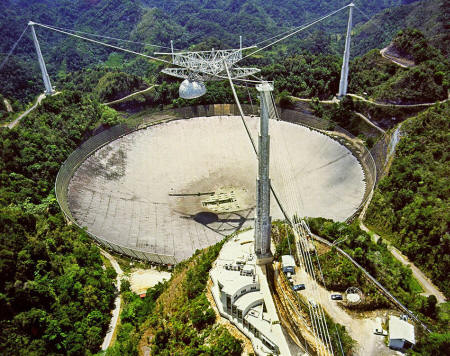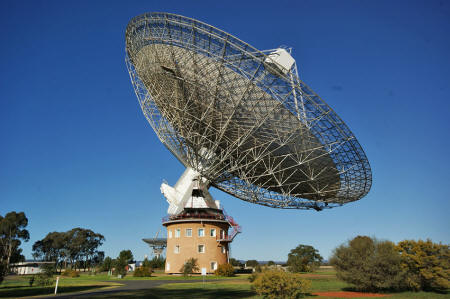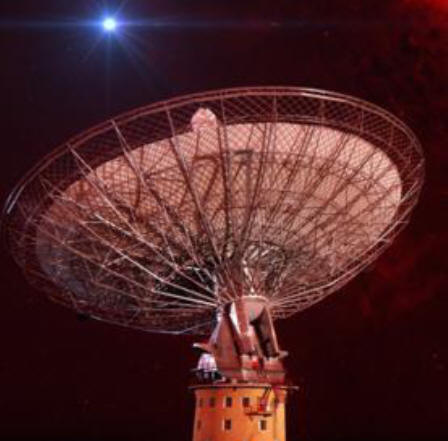Every now and then things go "bump!" in the cosmic night, releasing torrents of energy that astronomers can't easily explain.
Not that they mind: most times an energetic riddle flares up in their view of the sky, major epoch-setting discoveries are sure to follow. This was the pattern for pulsars - rapidly spinning city-size stellar remnants that steadily chirp in radio.
It was also the pattern for gamma-ray bursts - extreme explosions at the outskirts of the observable universe thought to be caused by stellar mergers and collapsing massive stars.
Now the pattern is playing out again, with last week's announcement that an international team of researchers has detected brief, bright bursts of radio waves washing over Earth from mysterious sources that may be billions of light-years away.
The findings, reported in the July 5 Science (A Population of Fast Radio Bursts at Cosmological Distances), could open an entirely new window on the universe by allowing scientists to measure the composition and dynamics of the intergalactic medium - the cold, diffuse plasma that lies between galaxies.
Using a year's worth of data gathered from some 10 percent of the sky by the 64-meter Parkes radio telescope in Australia, the team detected four bursts from far outside the galactic plane, each occurring only once and lasting a few thousandths of a second.
According to Dan Thornton, a PhD candidate at the University of Manchester in England who led the study, the results suggest that these "fast radio bursts," or FRBs, probably occur as often as every 10 seconds or so, nearly 10,000 times a day.
"If we had radio telescopes watching the entire sky, that's how many we think we'd see each day," Thornton says. "We haven't seen more of these until now only because we've been looking at small regions of the sky for small amounts of time."
"The discovery of fast radio bursts at the Parkes Observatory, if confirmed at other observatories, would be a monumental discovery, comparable to that of cosmological gamma-ray bursts and even pulsars," says Shrinivas Kulkarni, a Caltech astrophysicist who was not involved with the recent study.
"Great discoveries need the greatest proof, however, and I eagerly look forward to confirmation of these events at other radio bands and other observatories."
One flash, followed by years of uncertainty
In 2007 a different team discovered the first FRB entirely by chance while analyzing archival data from the Parkes telescope.
The astronomers' interest was piqued by an event from the night of August 24, 2001, when a five-millisecond burst whispered into the telescope from a seemingly blank region of sky near the Small Magellanic Cloud, a dwarf galaxy thought to orbit our Milky Way.
Examining the data in more detail, the team's leader, West Virginia University astrophysicist Duncan Lorimer, found something curious in the dispersion of the burst's wavelengths.
Its short-wavelength components had arrived at the telescope a fraction of a second before longer wavelengths, an effect that can be caused by longer-wavelength light moving ever so slightly slower through electrons in clouds of cold plasma that suffuse the space between stars and galaxies.
The longer the delay between the arrival of a burst's short and long wavelengths, the more intervening electrons it had passed through and the greater the distance it traveled. Lorimer and his colleagues were shocked by the results of their calculations, which suggested the burst had come from as much as a few billion light-years away.
Lorimer looked for the burst's repetition in some 90 hours of additional Parkes observations but came up empty.
Because of the burst's extreme brightness, short duration and singular occurrence, Lorimer suspected it might represent an entirely new, previously undetected astronomical radio source that astronomers might somehow use as a plumb line to investigate the ionized contents of the intergalactic medium.
Year after year his team's proposals to search for more such bursts were rejected, and separate searches found only one tentative candidate.
Other astronomers began suggesting the "Lorimer burst" might have been only some errant terrestrial signal caused by man-made interference or natural sources such as lightning.
Perhaps it had all been too good to be true.
"That kept us awake at night," Lorimer recalls. "We wondered whether what we had seen was just a fluke, an artifact."
The four new FRBs gathered by Thornton's team at Parkes have eliminated most lingering doubts.
The burst with the smallest wavelength dispersion seems to have reached us after passing through some 5.5 billion light-years of space; the burst with the largest dispersion appears to be from nearly twice as far out, originating some 10.4 billion light-years away.
One of the four bursts also bears the likely imprint of turbulence in the intergalactic medium, a subtle stretching out of its pulse shape probably caused by electron scattering.
Making those same measurements for further FRBs would give astronomers the unprecedented ability to estimate the strength of intergalactic magnetic fields.
From sources unknown
Even though their extragalactic origins are largely confirmed, the FRBs' sources remain unknown.
In follow-up multiwavelength observations, no trace of an FRB precursor or afterglow has been found, and because of the relatively low angular resolution of most current radio telescopes, astronomers have not been able to pinpoint any galaxy as a site for any FRB's source.
Based on each burst's brevity, brightness and far-distant origin, whatever generated them gave off a truly enormous amount of energy in radio waves, all from an emission region no bigger than a few hundred kilometers.
And yet, according to Thornton's colleague Matthew Bailes, an astronomy professor at Swinburne University of Technology in Melbourne, Australia, the signal from a mobile phone broadcasting from the surface of Earth's moon would be brighter than a typical FRB by a factor of 1,000.
Such apparent faintness, Thornton says, means that,
"it would take Parkes operating full-time for a million years to collect enough FRBs to equal the kinetic energy found in a single flying mosquito."
The high occurrence rate of FRBs paired with their immense intrinsic luminosity has, however, largely ruled out a handful of hypothesized sources.
The FRBs are too bright to be radio-wave burps of evaporating supermassive black holes at galactic centers, and they are far too frequent to be easily explained as the echoes from energetic mergers of neutron star pairs.
Similarly, gamma-ray bursts occur only about once a day, not often enough to be obviously associated with FRBs.
One new hypothesis, espoused by Heino Falcke of Radboud University Nijmegen in the Netherlands and Luciano Rezzolla of the Max Planck Institute for Gravitational Physics in Potsdam, posits that FRBs are the farewell messages of dying stars dubbed "blitzars," putative rapidly spinning "supramassive" neutron stars that would otherwise become black holes.
As a blitzar loses energy and spins down over time, it suddenly crosses a threshold where it can no longer support its weight, and as it collapses an FRB is emitted.
"When the black hole forms, the magnetic fields will be cut off from the star and snap like rubber bands," Falcke explained in a press release.
"As we show, this can indeed produce the observed giant radio flashes. All other signals you normally would expect - gamma rays, x-rays - simply disappear behind the event horizon of the black hole."
Bailes finds the blitzar explanation difficult to swallow; reconciling it with the estimated FRB occurrence rate would require the majority of neutron stars to be in this unlikely supramassive state.
Additionally,
"the problem with many of these more exotic scenarios is they aren't easily falsifiable," he says. "We wouldn't be able to detect anything else from these things after they're locked away behind a black hole's event horizon."
Bailes's preferred FRB source is something called a magnetar, rare neutron stars with the most powerful magnetic fields ever measured.
In the so-called 'Christmas event of 2004', Bailes notes, astronomers observed a magnetar flare up on the far side of the Milky Way in a "giant burst" (below video):
|
|
In a millisecond the magnetar erupted with a bit more energy than the sun releases in 300,000 years.
Astronomers believe the burst was caused by a starquake, a sudden rearrangement of the magnetar's structure to release built-up stresses associated with its whirling magnetic field.
"Even a tiny fraction of that energy converted to radio waves would give the kind of luminosity we need to satisfy an FRB's energetics, and the millisecond timescale is perfect for our duration," he says.
A 3-D map of matter
Although researchers may argue about an FRB's source, there is universal agreement about the mysterious bursts' applications.
"If we can trace an FRB to a specific galaxy, we can then independently measure the distance to that galaxy," Thornton says. "Comparing the FRB's dispersion measure with that galactic distance would yield the average electron density between Earth and that other galaxy."
And because all those electrons come from baryons - subatomic particles such as protons and neutrons - they would be a proxy measurement of the amount and distribution of unseen ordinary matter that exists between and even within far-distant galaxies.
"If we find many different FRB host galaxies at many different distances," Thornton says, "we can begin to create a 3-D map of intergalactic baryonic matter and magnetic fields."
Tracing FRBs to their galaxies would require their real-time detection by a radio telescope such as Parkes, rapidly followed by more detailed observations using high-resolution radio facilities such as the Jansky Very Large Array in New Mexico.
A new real-time detection scheme has just come online at Parkes, Bailes says, and the telescope has already observed more FRBs.
For Lorimer, the new discoveries are a vindication.
"I feel relieved," he says.
"It's been a long time coming. FRBs are really going to drive demand for the next generation of radio telescopes as we try to figure out what's making things go off all across the universe like this every 10 seconds.
For a while there will be more theories than individual detected bursts, but soon we'll have hundreds of these things from across the entire sky.
It's not very often in astronomy that you get completely new classes of objects coming along, especially ones as strange as these.
We are witnessing the birth of an entirely new area of research."





